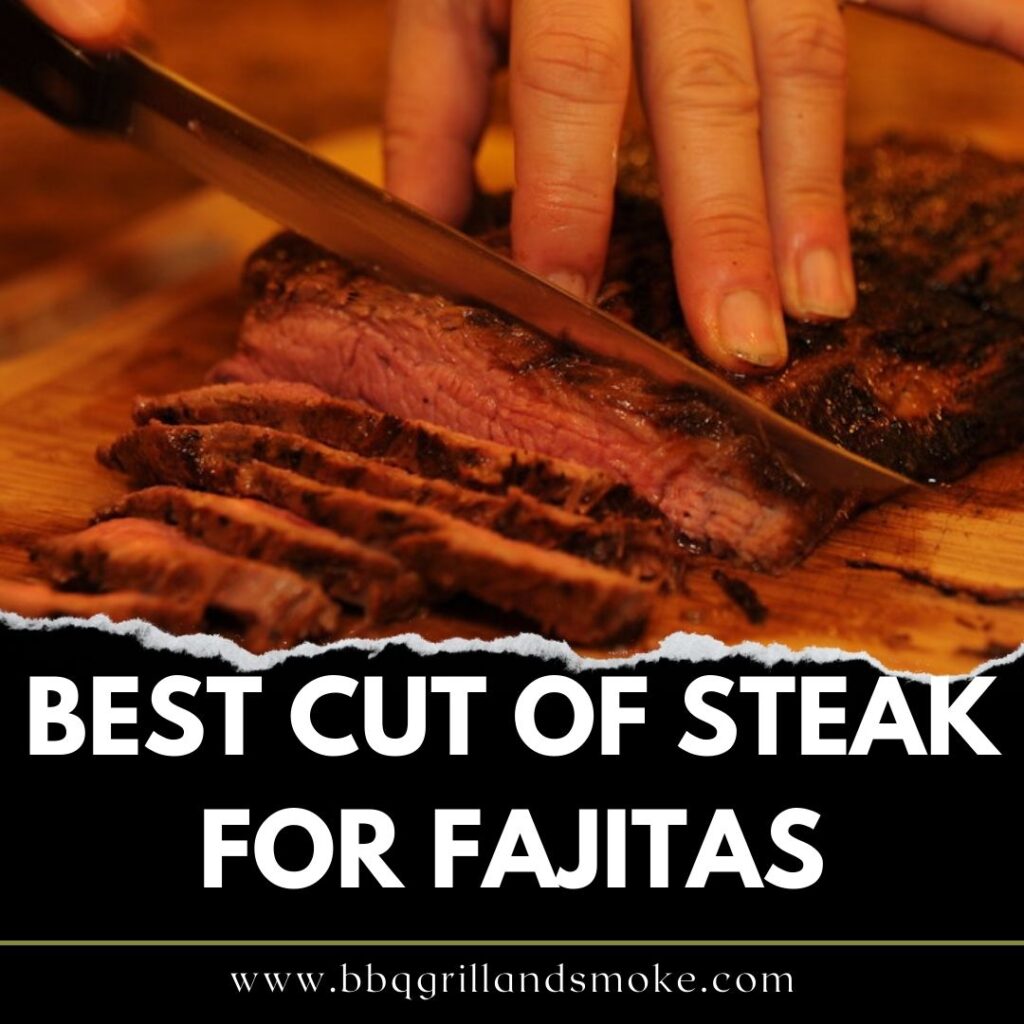This is a guide on the best cut of steak for fajitas, and in my opinion, I consider skirt steak to be the best cut of steak for fajitas.
It cooks in no time over a hot grill, can soak up a marinade with no stress (that is, if you are using one), and is meltingly succulent with a rich, beefy flavor.

So, let’s take a closer look at this guide on the best cut of steak for fajitas. Time to say goodbye to bland fajitas and welcome to delectableness.
What Are Fajitas, and What Is the Traditional Way of Preparation?
In Tex-Mex cuisine, fajitas are one of the most popular dishes.
It is quite an easy concept, and you need just a couple of ingredients for the dish itself.
However, the spice mix and meat used are what differentiate one recipe from the other.
Fajitas are a combination of grilled meat slices with sautéed slices of pepper and onions; this is when it is in its simplest form.
This delectable mixture is served on either a flour or corn tortilla.
A lot of people prefer to wrap it up to make it easier to eat, and you also have the option of serving it with rice, refried beans, salsa, or guacamole.
Presently, there are thousands of fajita recipes available that use several different meats and cuts.
You can make pork fajitas, fish fajitas, chicken fajitas, and, in addition, the original beef fajitas.
That being said, in the case of the exact type of meat used, it was skirt steak, traditionally.
As a matter of fact, it was so famous that a lot of people shouted that if it isn’t skirt steak, then it is not a fajita.
Fortunately, society has moved away from that belief, and in the world today, people use all different kinds of.
Now, with all that being said, what is the best cut of steak for fajitas?
What Is the Best Cut of Steak for Fajitas?
When it comes to fajitas, you have the option of using either skirt steak or flank steak.
Even though the two cuts are gotten from different parts of the cow, both skirt and flank steak soak up marinades well, cook fast, and taste tender and delicious when sliced thinly against the grain.
Skirt steak is a thin, tasty cut that is obtained from the diaphragm, found between the abdomen and chest.
There are two types of skirt steak: the inside skirt and the darker, more mineral-flavored outside skirt.
Both skirt steaks are well-known for high-heat cooking like grilling, and it’s highly recommended that they always be sliced against the grain.
The flank primal is found directly under the loin and forms part of the cow’s abdominal muscles.
Cuts from the flank are likely to be lean and extremely tough, but when properly cooked, they are delicious.
A flank steak’s coarse texture is advantageous when it comes to soaking up marinades.
Flank steak is best grilled over high heat, sliced thinly against the grain, or stir-fried.
Flap Steak
Another well-known fajita meat is flap meat. This cut of beef is referred to as sirloin fajitas in South Texas.
It is known as a “bavette” in some places and an “arrachera” in Mexico. And, in Arizona and New Mexico, it is also referred to as a “ranchera.”
Hanger Steak
The giant hanger steak is also a famous cut of meat for fajitas. Even though it is not as tough as a flank or skirt steak, it is more expensive.
In addition, it is referred to as an arrachera in South Texas.
However, they actually call this cut a “fajita” in some parts of Mexico and some parts of this country.
Frequently Asked Questions
Why Are These Cuts Used for Steak Fajitas?
If you ask them, the Mexicans or Texans will tell you that it is because these cuts are costly.
In addition, they soak up marinades well, and they become extremely succulent and flavorful when thinly sliced across the grain.
What are other Steaks Used for Fajitas?
Even though several other cuts of beef, like top round, sirloin, sirloin tip, London broil, sirloin flap, and flat iron steaks, are also used for fajitas, I strongly suggest that you avoid them, given that they are not ideal for fajitas.
Is There Another Name for Skirt Steak?
Skirt steak is also referred to as arrachera, Romanian steak, Romanian tenderloin, or Philadelphia steak outside of the US.
Should I Cut Steak Before Cooking for Fajitas?
Of course, yes, you should cut the steak thinly before cooking. In addition, it should be sliced across the grain, as this helps maximize tenderness.
How to Cook Fajitas Like a Pro
Let’s take a look at the best ways to cook fajitas like a professional chef or cook.
Get Your Grill or Cast Iron Ripping Hot
In the case of thinly cut steak, blasting heat is the name of the game. This permits you to achieve that dark crust without overcooking the insides.
Don’t Flip the Steak a Bunch of Times
Avoiding flipping the steak more than once is the secret to a good sear and retaining the juices. Simply use your thermometer and believe in yourself.
Use a Bit of Oil to Help with Sticking If Needed
Just use a neutral-tasting oil such as canola or vegetable oil if you didn’t marinate your steaks, as this will help prevent sticking.
Make Crosshatch Stitches with a Knife for Better Seasoning Results
Crosshatching your steaks before you rub them down with your marinade’s seasoning is one perfect way to get a little more vigor from your seasoning. I suggest you also poke holes with a fork.
Use a Thermometer for Perfect Results
It is quite simple to both undercook and overcook fajitas, both of which will result in tough, chewy bites.
Target for a perfect medium (135 degrees Fahrenheit) or just a little close to that for the ideal bites.
You can also improvise. A good place to begin for most steaks is around a pound if you are feeling bold, is 5 minutes on each side.
As a reminder, below are the temperature ranges for steaks:
- Rare: 130 degrees Fahrenheit
- Medium-rare: 135 degrees Fahrenheit
- Medium: 145 degrees Fahrenheit
- Medium-well: 150 degrees Fahrenheit
- Well done: 160 degrees Fahrenheit
Remember that your steak continues cooking even after you remove it from your grill or skillet, so ensure that you take it off 2-3 degrees before your desired temperature.
Always Rest the Meat before Slicing
When you remove them from the grill, the steaks are still cooking, and you are slicing them before the protein strands have time to rest and reabsorb their juices, which means you will spill all of that delectable flavor over your cutting board.
So, just chill and allow them to relax for 5 to 10 minutes while you cook the vegetables.
Cut Across the Grain
Cutting across the grain is an extremely important step after the meat has rested, which means cutting perpendicular to the musical fibers that run all over the meat, effectively snapping them. This actually causes tenderness.
Choose Meat from Healthy Cows
In comparison with industrial beef, organically raised, natural beef tastes better.
The taste of the meat is richer and the texture is better when your beef is free from additives and preservatives and the cows eat healthier diets during their lives.
Final Thoughts on the Best Cut of Steak for Fajitas
Remember that the skirt steak is the authentic fajita steak, but you can also use a flap, hanger, or flank steak.
The interesting thing about this recipe is that it is simple to cook.
Just purchase a steak and slice it across the grain. Make sure you keep the grill hot, then sear it.
You can serve your steak fajitas with a warm tortilla, any other toppings you like, and some lime wedges.
This finger-licking combination is a treat that will keep you craving more.
That being said, this brings us to the end of this guide on the best cut of steak for fajitas.





